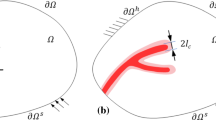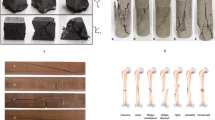Abstract
Anisotropy is inherent in many materials, either because of the manufacturing process, or due to their microstructure, and can markedly influence the failure behavior. Anisotropic materials obviously possess both anisotropic elasticity and anisotropic fracture surface energy. Phase-field methods are elegant and mathematically well-grounded, and have become popular for simulating isotropic and anisotropic brittle fracture. Here, we developed a variational phase-field model for strongly anisotropic fracture, which accounts for the anisotropy both in elastic strain energy and in fracture surface energy, and the asymmetric behavior of cracks in traction and in compression. We implement numerically our higher-order phase-field model with mixed finite element, inspired by formulations for plate/shell elements, where similar continuity requirements exist. For strongly anisotropic materials, as reported in the recent experiments, one could obtain several crack propagation directions for a given loading configuration, depending on imperfections of the initial crack. From an energy point of view, the selection of crack propagation direction is dictated by local principle of the generalized maximum energy release rate. Herein, for the first time we examine numerically this local principle, reproduce the crack behaviors observed in recent experiments. Numerical simulations exhibit all the features of strongly anisotropic fracture.









Similar content being viewed by others
References
Romero V, Roman B, Hamm E, Cerda E (2013) Spiral tearing of thin films. Soft Matter 9(34):8282
Lepillier B, Yoshioka K, Parisio F, Bakker R, Bruhn D (2020) Variational phase-field modeling of hydraulic fracture interaction with natural fractures and application to enhanced geothermal systems. J Geophys Res: Solid Earth 125(7):e2020JB019856
Francfort GA, Marigo JJ (1998) Revisiting brittle fracture as an energy minimization problem. J Mech Phys Solids 46:1319
Chen L, Verhoosel CV, de Borst R (2018) Discrete fracture analysis using locally refined T-splines. Internat J Numer Methods in Eng 116:117
Chen L, Li B, de Borst R (2019) Energy conservation during remeshing in the analysis of dynamic fracture. Internat J Numer Methods Eng 120:433
Daux C, Moës N, Dolbow J, Sukumar N, Belytschko T (2000) Arbitrary branched and intersecting cracks with the extended finite element method. Internat J Numer Methods Eng 48:1741
Gao Y, Liu Z, Zeng Q, Wang T, Zhuang Z, Hwang KC (2017) Theoretical and numerical prediction of crack path in the material with anisotropic fracture toughness. Eng Fracture Mech 180:330
Cervera M, Barbat G, Chiumenti M, Wu JY (2021) A comparative review of xfem, mixed fem and phase-field models for quasi-brittle cracking, Arch Comput Methods Eng, 1–75
Peerlings RHJ, de Borst R, Brekelmans WAM, de Vree JHP (1996) Gradient enhanced damage for quasi-brittle materials. Internat J Numer Methods Eng 39:3391
Verhoosel CV, Scott MA, Hughes TJR, de Borst R (2011) An isogeometric analysis approach to gradient damage models. Internat J Numer Methods in Eng 86:115
Pham K, Amor H, Marigo JJ, Maurini C (2011) Gradient damage models and their use to approximate brittle fracture. Internat J Damage Mech 20:618
De Lorenzis L, Maurini C (2021) Nucleation under multi-axial loading in variational phase-field models of brittle fracture, Internat J Fracture, p 1–21
Bourdin B, Francfort GA, Marigo JJ (2000) Numerical experiments in revisited brittle fracture. J Mech Phys Solids 48:797
Bourdin B (2007) Numerical implementation of the variational formulation for quasi-static brittle fracture. Interfaces Free Bound 9:411
Tanné E, Li T, Bourdin B, Marigo JJ, Maurini C (2018) Crack nucleation in variational phase-field models of brittle fracture. J Mech Phys Solids 110:80
de Borst R, Verhoosel CV (2016) Gradient damage vs phase-field approaches for fracture: Similarities and differences. Comput Methods Appl Mech Engrg 312:78
Yin B, Steinke C, Kaliske M (2020) Formulation and implementation of strain rate-dependent fracture toughness in context of the phase-field method. Internat J Numer Methods Eng 121(2):233
Bleyer J, Alessi R (2018) Phase-field modeling of anisotropic brittle fracture including several damage mechanisms. Comput Methods Appl Mech Engrg 336:213
Takei A, Roman B, Bico J, Hamm E, Melo F (2013) Forbidden directions for the fracture of thin anisotropic sheets: an analogy with the Wulff plot. Phys Rev Lett 110:144301
Judt PO, Ricoeur A, Linek G (2015) Crack path prediction in rolled aluminum plates with fracture toughness orthotropy and experimental validation. Eng Fracture Mech 138:33
Judt PO, Zarges JC, Feldmann M, Ricoeur A, Heim HP (2019) Deflecting mode-i cracks in anisotropic materials. Mech Materials 136:103060
Li B, Peco C, Millán D, Arias I, Arroyo M (2015) Phase-field modeling and simulation of fracture in brittle materials with strongly anisotropic surface energy. Internat J Numer Methods Eng 102:711
Li B, Maurini C (2019) Crack kinking in a variational phase-field model of brittle fracture with strongly anisotropic surface energy. J Mech Phys Solids 125:502
Torabi S, Lowengrub J (2012) Simulating interfacial anisotropy in thin-film growth using an extended cahn-hilliard model. Phys Rev E 85(4):041603
Teichtmeister S, Kienle D, Aldakheel F, Keip MA (2017) Phase field modeling of fracture in anisotropic brittle solids. Internat J Non-Linear Mech 97:1
Kakouris EG, Triantafyllou SP (2019) Phase-field material point method for dynamic brittle fracture with isotropic and anisotropic surface energy. Comput Methods Appl Mech Engrg 357:112503
Ma R, Sun W (2020) FFT-based solver for higher-order and multi-phase-field fracture models applied to strongly anisotropic brittle materials. Comput methods appl Mech engrg 362:112781
Liu Y, Cheng C, Ziaei-Rad V, Shen Y (2021) A micromechanics-informed phase field model for brittle fracture accounting for unilateral constraint. Eng Fracture Mech 241:107358
van Dijk NP, Espadas-Escalante JJ, Isaksson P (2020) Strain energy density decompositions in phase-field fracture theories for orthotropy and anisotropy. Internat J Solids Struct 196:140
Storm J, Supriatna D, Kaliske M (2020) The concept of representative crack elements for phase-field fracture: Anisotropic elasticity and thermo-elasticity. Internat J Numer Methods Eng 121(5):779
Zhang S, Jiang W, Tonks MR (2020) A new phase field fracture model for brittle materials that accounts for elastic anisotropy. Comput Methods Appl Mech Engrg 358:112643
Zhang S, Kim DU, Jiang W, Tonk MR (2021) A phase field model of crack propagation in anisotropic brittle materials with preferred fracture planes. Comput Mater Sci 193:110400
He QC, Shao Q (2019) Closed-form coordinate-free decompositions of the two-dimensional strain and stress for modeling tension-compression dissymmetry. J Appl Mech 86(3):031007
Alnæs M, Blechta J, Hake J, Johansson A, Kehlet B, Logg A, Richardson C, Ring J, Rognes ME, Wells GN (2015) The FEniCS project version 1.5. Arch Numer Software 3:9
Hale JS, Brunetti M, Bordas SPA, Maurini C (2018) Simple and extensible plate and shell finite element models through automatic code generation tools. Comput & Struct 209:163
Marigo JJ, Maurini C, Pham K (2016) An overview of the modelling of fracture by gradient damage models. Meccanica 51:3107
Amor H, Marigo JJ, Maurini C (2009) Regularized formulation of the variational brittle fracture with unilateral contact: numerical experiments. J Mech Phys Solids 57:1209
Desmorat B, Auffray N (2019) Space of 2d elastic materials: a geometric journey. Contin Mech Thermodyn 31(4):1205
Mehrabadi MM, Cowin SC (1990) Eigentensors of linear anisotropic elastic materials. The Quart J Mech Appl Math 43(1):15
Horn RA, Johnson CR (1994) Topics in matrix analysis. Cambridge University Press, New York
Lubarda V, Krajcinovic D, Mastilovic S (1994) Damage model for brittle elastic solids with unequal tensile and compressive strengths. Eng Fracture Mech 49(5):681
Hale JS, Brunetti M, Bordas SP, Maurini C (2018) Simple and extensible plate and shell finite element models through automatic code generation tools. Comput & Struct 209:163
Li B, Millán D, Torres-Sánchez A, Roman B, Arroyo M (2018) A variational model of fracture for tearing brittle thin sheets. J Mech Phys Solids 119:334
Chen L, Li B, de Borst R (2021) The use of powell-sabin b-splines in a higher-order phase-field model for crack kinking. Comput Mech 67(1):127
Nguyen TT, Yvonnet J, Waldmann D, He QC (2020) Implementation of a new strain split to model unilateral contact within the phase field method. Inter J Numer Methods Eng 121(21):4717
Alnæs MS, Logg A, Ølgaard KB, Rognes ME, Wells GN (2014) Unified form language: A domain-specific language for weak formulations of partial differential equations. ACM Trans Math Softw (TOMS) 40(2):1
Logg A, Mardal KA, Wells GN (2012) Automated solution of differential equations by the finite element method: The FEniCS book, vol 84. Springer, Heidelberg-Dordrecht
Chambolle A, Francfort GA, Marigo JJ (2009) When and how do cracks propagate? J Mech Phys Solids 57(9):1614
Klinsmann M, Rosato D, Kamlah M, McMeeking RM (2015) An assessment of the phase field formulation for crack growth. Comput Methods App Mech Eng 294:313
Kristensen PK, Niordson CF, Martínez-Pañeda E (2021) An assessment of phase field fracture: crack initiation and growth. Philos Trans Roy Soc A 379(2203):20210021
Author information
Authors and Affiliations
Corresponding author
Additional information
Publisher's Note
Springer Nature remains neutral with regard to jurisdictional claims in published maps and institutional affiliations.
Rights and permissions
About this article
Cite this article
Luo, Z., Chen, L., Wang, N. et al. A phase-field fracture model for brittle anisotropic materials. Comput Mech 70, 931–943 (2022). https://doi.org/10.1007/s00466-022-02192-9
Received:
Accepted:
Published:
Issue Date:
DOI: https://doi.org/10.1007/s00466-022-02192-9




